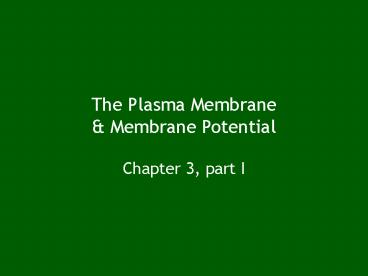The cell theory has six principles. - PowerPoint PPT Presentation
1 / 28
Title:
The cell theory has six principles.
Description:
diffusion can occur through a permeable membrane. Diffusion in the Body ... impaired sodium reabsorption of the sudoriferous glands. Carrier-Mediated Transport ... – PowerPoint PPT presentation
Number of Views:335
Avg rating:3.0/5.0
Title: The cell theory has six principles.
1
The Plasma Membrane Membrane Potential
Chapter 3, part I
2
The Plasma Membrane
- fluid lipid bilayer
- hydrophobic core surrounds hydrophilic outside
- embedded molecules
- proteins, carbohydrates, cholesterol
3
Plasma Membrane Proteins
- channels
- carrier molecules
- docking-marker acceptors
- membrane-bound enzymes
- receptor molecules
- cell adhesion molecules
4
Cell Adhesions
- desmosomes
- spot rivets
- gap junctions
- tunnels connecting cells
- tight junctions
- points of direct contact
5
Cell-to-Cell Connections
6
Diffusion Net Flux
7
Chemical Driving Forces
8
Membrane Diffusion
- unassisted membrane transport
- depends on the random movement of molecules
- net movement is DOWN the concentration gradient
- diffusion can occur through a permeable membrane
9
Diffusion in the Body
- O2 CO2 exchange in the lungs
- kidney filtration
- Na K ions through channel proteins
10
Five Factors Affect Diffusion
- magnitude of the concentration gradient
- membrane permeability
- surface area of the membrane
- the size of a substance
- the distance through which diffusion takes place
11
Diffusion Over Time
12
The Electrochemical Gradient
- permeable ions move passively
- electrical AND concentration gradients
- difference in charge produces an electrical
gradient
13
Electrical Driving Force
14
Osmosis
15
Osmosis
penetrating solute
non-penetrating solute
16
The Plasma Membrane Membrane Potential
Chapter 3, part II
17
Tonicity
- the effect the solution has on cell volume
- isotonic solution when nonpenetrating solute
cells - hypotonic solution when nonpenetrating solute
lt cells - hypertonic solution when nonpenetrating solute
gt cells
18
Carrier-Mediated Transport
- carrier molecule flipping changing shape
- active or passive (energy use)
- three important characteristics
- specificity
- saturation
- competition
19
Cystic Fibrosis
- impaired release of Cl-
- dehydration of surrounding respiratory
intestinal mucosa - impaired sodium reabsorption of the sudoriferous
glands
20
Carrier-Mediated Transport
- facilitated diffusion
- substance moves along concentration gradient
- requires a carrier molecule
- does not require energy expenditure
- primary active transport
- movement against gradient
- requires a carrier molecule
- direct use of ATP (energy)
- carrier mediated transport
21
Secondary Active Transport
- secondary active transport
- uses previously existing concentration gradient
- co-transporter
- counter-transporter/exchanger
22
Pumps Leaks
23
Membrane Potential
- separation of charges across plasma membrane
- concentration permeability differences of key
ions - cell develops a resting membrane
- resting potential
24
Vesicular Transport Systems
25
Epithelium Structure
26
Epithelial Solute Transport
27
Epithelial Water Transport
28
Transcytosis































